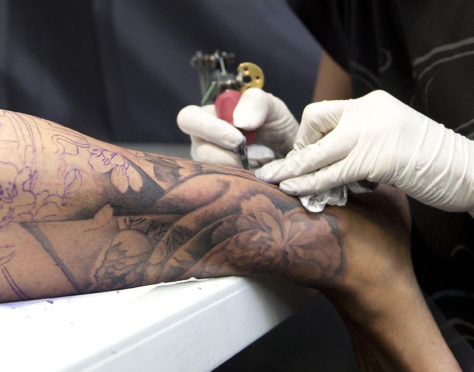
Infection control in shops offering tattoos and piercings needs to be overhauled, after almost a fifth of customers suffered negative effects over the last five years, according to a report.
Some 18% of people who have had a tattoo, cosmetic piercing, acupuncture or electrolysis in the last five years experienced side effects, most commonly burning or swelling, a survey for the Royal Society for Public Health (RSPH) suggests.
One in 10 of those who experienced problems needed medical treatment.
There is no standard legal infection control requirement across the UK for anyone offering tattoos, piercings or other treatments that compromise the skin barrier, the RSPH said.
It warned that currently this meant that anyone can set up shop without appropriate training, and could ultimately put people at risk of infection.
There is also no specific legislation covering other equally invasive treatments, such as dermal fillers.
The RSPH also warned that anyone could buy specialist equipment online to carry out tattooing or piercings, without the necessary training or qualifications in how to use them.
There was a 173% increase in the number of tattoo parlours in the decade to 2014, the RSPH said. One in five people now have a tattoo.
The survey found two fifths of people who had a special procedure did not check whether the person carrying it out was registered or licensed, while the most important factor influencing where they had their procedure was the skill of the technician, followed by the cleanliness of the premises and recommendations by previous clients.
Nine in ten (90%) of the UK public believe that people who carry out such special procedures should be legally required to hold an infection control qualification, the survey suggests.
RSPH is calling for suppliers to only sell tattoo and piercing equipment to those who can provide evidence of their registration or licencing with their local authority, and for all UK health systems to require an an infection control qualification as part of licensing.
It said infections linked to special procedures should be included in the list of notifiable diseases that must be reported to local councils or local health protection teams.
It also wants all UK governments to make non-surgical cosmetic procedures such as dermal fillers and botox illegal for under 18s.
RSPH chief executive Shirley Cramer said: “The growing popularity of tattoos, piercings and cosmetic procedures is all part and parcel of people choosing to express themselves and their individual identity.
“However, the legislation and regulation of providers of these services, which ultimately protects the public, is markedly different across the UK and in some areas is not fit for purpose.
“This matters because one in five people are still at very real risk of sepsis and other complications.
“We would call on the rest of the UK to follow the example set by Wales to ensure infection control and other health risks are minimised, by introducing a mandatory licensing scheme which will require practitioners in place to ensure that the risk of complications is reduced.”
Populus surveyed 2,000 members of the UK public between May 31 and June 2. RSPH also surveyed 886 individuals who had a special procedure in the last five years between March and June.

Enjoy the convenience of having The Sunday Post delivered as a digital ePaper straight to your smartphone, tablet or computer.
Subscribe for only £5.49 a month and enjoy all the benefits of the printed paper as a digital replica.
Subscribe